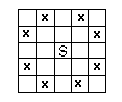
Zadanie Nieatakujące się skoczki (nie)
Pomóż nam usprawnić bazę zadań!
Nieatakujące się skoczki
Limit pamięci: 32 MB
Skoczek jest figurą, która atakuje pola na szachownicy zgodnie z poniższym rysunkiem
(skoczek umieszczony w polu  atakuje pola oznaczone przez krzyżyk).
atakuje pola oznaczone przez krzyżyk).

Dana jest szachownica o rozmiarach  — mająca
— mająca  wiersze i
wiersze i  kolumn, gdzie
kolumn, gdzie  —
oraz zbiór
—
oraz zbiór  pól na tej szachownicy.
Wiersze na szachownicy są ponumerowane od góry do dołu liczbami od
pól na tej szachownicy.
Wiersze na szachownicy są ponumerowane od góry do dołu liczbami od  do
do  , a kolumny od lewej do prawej liczbami od
, a kolumny od lewej do prawej liczbami od  do
do  .
.
Na szachownicy wolno rozmieszczać skoczki tylko na polach nie należących do  oraz tak,
aby żadne dwa nie atakowały się nawzajem.
Zakładamy, że w każdej kolumnie co najwyżej jedno pole należy do
oraz tak,
aby żadne dwa nie atakowały się nawzajem.
Zakładamy, że w każdej kolumnie co najwyżej jedno pole należy do  .
Zbiór
.
Zbiór  można więc opisać w postaci ciągu:
można więc opisać w postaci ciągu:  , gdzie
, gdzie  .
Wartość
.
Wartość  oznacza, że żadne pole w
oznacza, że żadne pole w  -tej kolumnie nie należy do
-tej kolumnie nie należy do  ,
zaś wartość
,
zaś wartość  jest numerem wiersza jedynego pola w tej kolumnie, które należy do
jest numerem wiersza jedynego pola w tej kolumnie, które należy do  .
.
Zadanie
Ułóż program, który:
- wczytuje ze standardowego wejścia liczbę kolumn na szachownicy
 oraz opis zbioru pól
oraz opis zbioru pól  ,
,
- znajduje maksymalną liczbę skoczków
 , które można ustawić na szachownicy zgodnie z podanymi zasadami oraz liczbę
, które można ustawić na szachownicy zgodnie z podanymi zasadami oraz liczbę  wszystkich takich ustawień
wszystkich takich ustawień  skoczków,
skoczków,
- zapisuje wyniki na standardowe wyjście.
Wejście
W pierwszym wierszu standardowego wejścia jest zapisana jedna liczba całkowita dodatnia  ,
,  .
Jest to liczba kolumn szachownicy.
W każdym z kolejnych
.
Jest to liczba kolumn szachownicy.
W każdym z kolejnych  wierszy jest zapisana jedna liczba ze zbioru
wierszy jest zapisana jedna liczba ze zbioru  .
Są to kolejne wyrazy ciągu będącego opisem zbioru pól
.
Są to kolejne wyrazy ciągu będącego opisem zbioru pól  .
.
Wyjście
Na standardowe wyjście należy zapisać dwie liczby całkowite  i
i  oddzielone odstępem.
oddzielone odstępem.
Przykład
Dla danych wejściowych:
2 1 0
poprawną odpowiedzią jest:
4 2
Autor zadania: Wojciech Rytter.
Kontakt
In the event of technical difficulties with Szkopuł, please contact us via email at [email protected].
If you would like to talk about tasks, solutions or technical problems, please visit our Discord servers. They are moderated by the community, but members of the support team are also active there.

 English
English